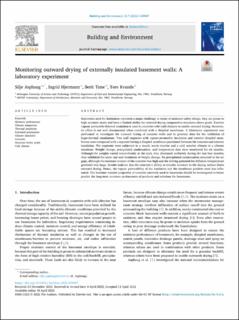| dc.contributor.author | Asphaug, Silje Kathrin | |
| dc.contributor.author | Hjermann, Ingrid | |
| dc.contributor.author | Time, Berit | |
| dc.contributor.author | Kvande, Tore | |
| dc.date.accessioned | 2022-04-26T13:59:09Z | |
| dc.date.available | 2022-04-26T13:59:09Z | |
| dc.date.created | 2022-04-22T09:06:51Z | |
| dc.date.issued | 2022 | |
| dc.identifier.issn | 0360-1323 | |
| dc.identifier.uri | https://hdl.handle.net/11250/2992890 | |
| dc.description.abstract | Basements used for habitation represent a major challenge in terms of moisture safety design; they are prone to high moisture strain and have a limited ability for outward drying compared to structures above grade. Exterior vapour-permeable thermal insulation is used in countries with cold climates to enable outward drying. However, its effect is not well documented when combined with a dimpled membrane. A laboratory experiment was performed to investigate the outward drying of concrete walls and to generate data for the validation of hygrothermal simulations. Two wall segments with vapour-permeable insulation and exterior dimpled membranes were compared with a segment having a dimpled membrane positioned between the concrete and exterior insulation. The segments were subjected to a steady warm interior and a cold exterior climate in a climate simulator. Weight change, precipitated condensation, and temperature data were monitored for six months. Although the weights varied nonuniformly at the start, they decreased uniformly during the last four months; they exhibited the same rate and variations of weight change. No precipitated condensation occurred in the air gaps, although the moisture content of the concrete was high and the driving potential for diffusion (temperature gradient) was large. Results indicate that the concrete's ability to transfer moisture to the drying surface limits outward drying. Hence, the vapour permeability of the insulation and the membrane position were less influential. The moisture transfer properties of concrete currently used in basements should be investigated to better predict the long-term moisture performance of products and solutions for basements. | |
| dc.language.iso | eng | en_US |
| dc.publisher | Elsevier | en_US |
| dc.rights | CC BY 4.0 | * |
| dc.rights.uri | https://creativecommons.org/licenses/by/4.0/ | |
| dc.subject | Moisture performance | en_US |
| dc.subject | Climate adaptation | en_US |
| dc.subject | Thermal insulation | en_US |
| dc.subject | Extruded polystyrene | en_US |
| dc.subject | Climate simulator | en_US |
| dc.subject | Concrete | en_US |
| dc.subject | Structure below grade | en_US |
| dc.subject | Cold climate | en_US |
| dc.title | Monitoring outward drying of externally insulated basement walls: A laboratory experiment | en_US |
| dc.type | Peer reviewed | en_US |
| dc.type | Journal article | en_US |
| dc.description.version | publishedVersion | en_US |
| dc.rights.holder | © 2022 The Authors. | en_US |
| dc.subject.nsi | VDP::Teknologi: 500 | en_US |
| dc.source.volume | 217 | en_US |
| dc.source.journal | Building and Environment | en_US |
| dc.identifier.doi | 10.1016/j.buildenv.2022.109097 | |
| dc.identifier.cristin | 2018298 | |
| dc.relation.project | Norges forskningsråd: 237859 | en_US |
| dc.source.articlenumber | 109097 | en_US |
| cristin.ispublished | true | |
| cristin.fulltext | postprint | |
| cristin.fulltext | original | |
| cristin.qualitycode | 2 | |

